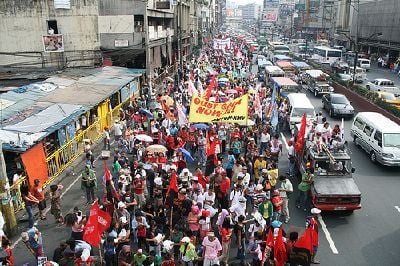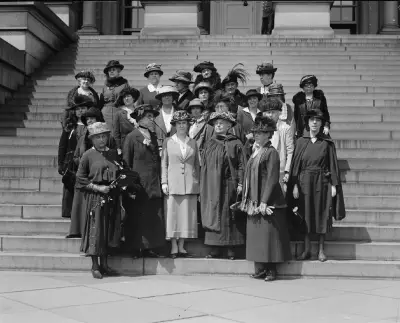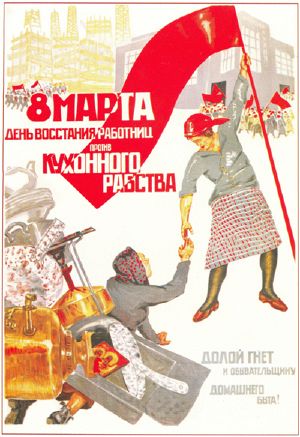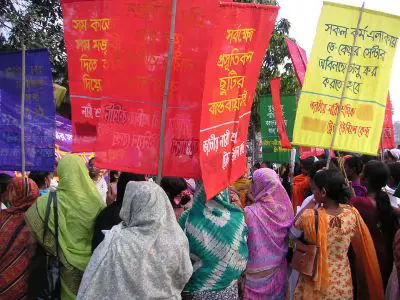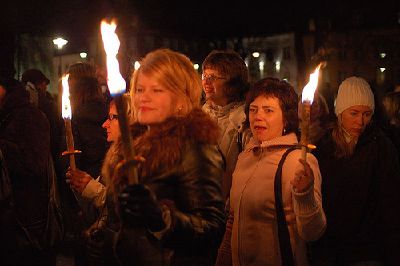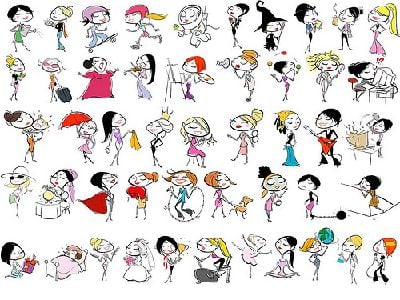Difference between revisions of "International Women's Day" - New World Encyclopedia
m |
|||
| (47 intermediate revisions by 6 users not shown) | |||
| Line 1: | Line 1: | ||
| − | [[ | + | {{Images OK}}{{submitted}}{{approved}}{{copyedited}} |
| + | {{Infobox Holiday | ||
| + | | image = Cameroon IWD.jpg | ||
| + | | caption = International Women's Day provides a chance for [[Cameroon]]ian women to buy brightly colored fabric. They also get to drink in the bars. | ||
| + | | holiday_name = International Women's Day | ||
| + | | frequency = Annual | ||
| + | | observedby = Worldwide | ||
| + | | scheduling = Same day each year | ||
| + | | mdy = yes | ||
| + | | date = March 8 | ||
| + | | type = International | ||
| + | | significance = {{plainlist| | ||
| + | * Civil awareness day | ||
| + | * Women and girls day | ||
| + | * [[Sexism|Anti-sexism]] day | ||
| + | * Anti-Discrimination Day | ||
| + | }}}} | ||
| − | '''International Women's Day''' ( | + | '''International Women's Day''' (IWD), marked annually on March 8, is a major day of global celebration for the economic, political, and social achievements of women. The day commemorates the political protests on March 8, 1857, 1859, and 1908, when women marched through [[New York City]] demanding shorter hours, better pay, and voting rights. |
| − | + | The holiday that developed from these beginnings blended the culture of many countries, especially [[Russia]] and the countries of the former [[Soviet Union|Soviet bloc]]. Many celebrations of the day emphasize the political and [[human rights]] theme for women, as designated by the [[United Nations]]. In others, the flavor of the day is not very political and is mainly an occasion for men to express their love to the women around them, similar to [[Mother's Day]] and [[Valentine's Day]]. | |
| − | + | {{toc}} | |
| + | International Women's Day is often celebrated as the first spring holiday, falling close to the first day of the spring season. | ||
| − | + | [[Image:Philippines IWD 2008.jpg|thumb|400px|4,000 women and their supporters marched through downtown Manila in 2008]] | |
==History== | ==History== | ||
| − | |||
| − | |||
| − | + | [[Image:National Women's Suffrage Association.jpg|thumb|300px|left|[[Women's suffrage]] movement]] | |
| − | + | In the later half of the turbulent nineteenth century amid rapid world [[industrialization]], there was great population growth and many new ideas were being born. Women began to seek better treatment at their work sites and other rights. On March 8, 1857, women garment workers in New York City demonstrated against their inhumane working conditions and low wages. They were attacked by the police and dispersed. Two years later, the first female [[labor union]] was formed by these women to try to protect themselves, asking for basic rights in the workplace.<ref>Temma Kaplan, On the Socialist Origins of International Women's Day, in ''Feminist Studies,'' 11, 1985, S. 163-171.</ref> | |
| − | [[ | + | On March 8, 1908, 15,000 women marched through [[New York City]] demanding shorter work hours, better pay, voting rights, and an end to child labor. Their slogan was "Bread and Roses," bread symbolizing economic security, and roses meaning a better quality of life. In May, the [[Socialist Party]] of America designated the last Sunday in February for the observance of National Women's Day. Following the Socialist Party's declaration, the first ever National Woman's Day was celebrated in the United States on February 28, 1909. Women continued to celebrate it on the last Sunday of that month through 1913. |
| − | |||
| − | + | [[Image:Zetkin luxemburg1910.jpg|thumb|300px|[[Clara Zetkin]] (left) and [[Rosa Luxemburg]], 1910]] | |
| − | [[ | + | An international Women's Day was soon proposed at a conference in [[Copenhagen]] in 1910, held by socialist organizations from around the world. Clara Zetkin, a German socialist, suggested the idea to commemorate the [[strike]] of garment workers in the United States. The proposal received unanimous approval by over 100 women from 17 countries, including the first three women elected to the parliament of [[Finland]]. Beyond the garment workers strike, the Day was established to honor the movement for women's rights in general, including the right to vote ([[suffrage]]). At that time, no fixed date was selected for the observance. |
| − | + | This declaration caused an International Women's Day to be commemorated in 1911 for the first time in [[Austria]], [[Denmark]], [[Germany]], and [[Switzerland]]. March 19 saw over a million men and women in a series of rallies worldwide. In addition to calling for the right for women to vote and to hold public office, they demanded the right to work and an end to discrimination on the job. | |
| + | [[Image:Women's International League, 5. 1. 1922.png|thumb|400px|Founded in 1915 in Washington, DC, the Women's International League for Peace and Freedom (WILPF) is the world's oldest women's peace organization.]] | ||
| − | + | On March 25, 1911, a tragic accident in New York City took the lives of over 140 workers, mostly young Italian and Jewish immigrant girls working at the Triangle Shirtwaist Company, due to a lack of safety measures. [[The Women's Trade Union League]] and the [[International Ladies' Garment Workers Union]] led many of the protests against this avoidable disaster. A silent funeral march brought out over 100,000 people. Subsequent International Women's Day commemorations often reminded participants of this horrific event. | |
| − | [[ | + | [[Russia]]n women observed their first International Women's Day on the last Sunday in February 1913 to strike for "bread and peace" during the era of [[World War I]]. Political leaders opposed the timing of the strike, but the women went on anyway. The demonstrations proved to be an early stage of the [[Russian Revolution of 1917]]. Four days after the demonstration, the Czar of Russia abdicated and the provisional government granted Russian women the right to vote. Women held rallies in Europe on or around March 8, either to protest the war or to express solidarity with their sisters. |
| − | + | [[Image:8marta.jpg|thumb|300px|The 1932 Soviet poster dedicated to the March 8 holiday.]] | |
| + | The poster (right) depicts the original spirit of IWD in the former Soviet Union, "The 8th of March is the day of the rebellion of the working women against kitchen slavery" and "Down with the oppression and narrow-mindedness of household work!" | ||
| − | + | Following the [[October Revolution]], the [[Bolshevik]] feminist [[Alexandra Kollontai]] persuaded [[Lenin]] to make International Women's Day an [[holiday|official holiday]] in Russia. It was duly established, but was a working day until 1965. On May 8, 1965, by the decree of the USSR [[Presidium of the Supreme Soviet]] International Women's Day was declared as a non-working holiday in the [[USSR]] "in commemoration of outstanding merits of the Soviet women in communistic construction, in the defense of their Motherland during the [[Great Patriotic War]], their heroism and selflessness at the front and in rear, and also marking the big contribution of women to strengthening friendship between peoples and the struggle for peace." | |
| − | + | Associated as it was with leftist causes, the IWD waned in popularity outside of the Soviet bloc until well after [[WWII]], but was revived by the rise of [[feminism]] in the 1960s. Since that time, International Women's Day has increased in importance as a platform for supporting women's rights in developed and developing countries alike. | |
| − | In | + | In December 1977, the UN General Assembly adopted a resolution proclaiming a [[United Nations Day for Women's Rights and International Peace]]. The United Nations has held four global conferences which support the demand for women's rights and participation in the political and economic process and make it a growing reality. |
| − | |||
| − | + | In 1975, the UN drew global attention to women's concerns by calling for an [[International Women's Year]] and convening the first conference on women in [[Mexico City]]. The next was held in [[Copenhagen]] in 1980. The third was held in 1985, in [[Nairobi]]. In 1995, [[Beijing]] hosted the [[Fourth World Conference on Women]] for representatives from 189 countries, who agreed that inequalities between women and men have serious consequences for the well-being of all people. | |
| + | [[Image:8marchrallydhaka (55).JPG|thumb|400px|March 8 rally in [[Dhaka]], [[Bangladesh]]]] | ||
| − | Five years later, in a | + | The conference declared a set of goals for progress of women in various areas including [[politics]], [[health]], and [[education]]. The final document issued by the conference (called the "[[Platform for Action]]") states: "The advancement of women and the achievement of equality between women and men are a matter of human rights and a condition for social justice and should not be seen in isolation as a women's issue." |
| + | |||
| + | Five years later, in a twenty-third special session of the [[United Nations General Assembly]] a report, "Women 2000: Gender Equality, Development and Peace for the 21st Century" reviewed the progress the world has made towards achieving the goals set out by the Beijing conference. Known as the "Beijing +5" conference, delegates found both progress and persevering obstacles. The delegates made "further agreements to continue carrying out the initiatives of the 1995 women's conference."<ref>[https://www.un.org/womenwatch/daw/followup/session/presskit/gasp.htm "Women 2000: Gender Equality, Development and Peace for the Twenty-first Century"] United Nations General Assembly Special Session, New York, 5-9 June 2000. Retrieved March 9, 2022.</ref> | ||
==Results== | ==Results== | ||
| − | [[Image:Oslo Norway IWD candle light.jpg|thumb| | + | [[Image:Oslo Norway IWD candle light.jpg|thumb|400px|A candlelight walk in Oslo, Norway 2007]] |
As a result of the international focus on Women in 1975, a number of institutions were established: | As a result of the international focus on Women in 1975, a number of institutions were established: | ||
* [[International Research and Training Institute for the Advancement of Women]] (INSTRAW) | * [[International Research and Training Institute for the Advancement of Women]] (INSTRAW) | ||
* [[United Nations Development Fund for Women]] (UNIFEM) | * [[United Nations Development Fund for Women]] (UNIFEM) | ||
| − | * [[International Women's Tribune Center]], 1976<ref>[ | + | * [[International Women's Tribune Center]], 1976<ref>[https://www.iwtc.org/ Connecting Women Globally for Social Change] ''International Women's Tribune Centre'' (IWTC). Retrieved March 9, 2022.</ref> |
| − | * [[Women's Studies Resource Centre]] was established in [[South Australia]] during July<ref>[ | + | * [[Women's Studies Resource Centre]] was established in [[South Australia]] during July<ref>[https://www.samemory.sa.gov.au/site/page.cfm?u=677 Women's Movement page 6.] ''State Library South Australia''. Retrieved March 9, 2022.</ref> |
| − | * [[Women's Electoral Lobby]] in | + | * [[Women's Electoral Lobby]] in Australia<ref> [http://www.wel.org.au/ Women's Electoral Lobby]. Retrieved March 9, 2022.</ref> |
| − | Also, the United Nations | + | Also, the United Nations made women's issues a high priority item on their Millennium Development Goals (MDG). |
== Women's Day in modern culture == | == Women's Day in modern culture == | ||
| − | |||
| − | |||
| − | |||
| − | |||
| − | + | The day is an official holiday in [[Albania]], [[Algeria]], [[Armenia]], [[Azerbaijan]], [[Belarus]], [[Bosnia and Herzegovina]], [[Brazil]], [[Burkina Faso]], [[Cameroon]], [[China]], [[Cuba]], [[Italy]], [[Laos]], [[Kazakhstan]], [[Kyrgyzstan]], [[Republic of Macedonia|Macedonia]], [[Moldova]], [[Mongolia]], [[Montenegro]], [[Poland]], [[Romania]], Russia, [[Serbia]], [[Tajikistan]], [[Ukraine]], [[Uzbekistan]], [[Vietnam]], and [[Zambia]], and is observed by men giving the women in their lives—mothers, wives, girlfriends, colleagues, and so on—flowers and small gifts. In some countries (such as Romania) it is also observed as an equivalent of [[Mother's Day]], where children also give small presents to their mothers and grandmothers. | |
| − | + | After the collapse of the Soviet Union, celebrations of IWD were abandoned in Armenia. Instead April 7 was introduced as a state holiday of "Beauty and Motherhood." The new holiday immediately became popular among [[Armenians]], as it commemorates one of the main holidays of the [[Armenian Apostolic Church|Armenian Church]], [[Annunciation]]. However, people still celebrate IWD on March 8 as well. | |
| − | In Bosnia and Herzegovina, Brazil, [[Croatia]], [[Hungary]], Romania, Moldova, Macedonia, Montenegro, Poland, [[Bulgaria]], [[Slovenia]] and Serbia the custom of giving women flowers | + | In Italy, men give [[Acacia dealbata|yellow mimosas]] to women to celebrate the day. Yellow mimosas and chocolate are also one of the most common March 8 presents in Russia. In Bosnia and Herzegovina, Brazil, [[Croatia]], [[Hungary]], Romania, Moldova, Macedonia, Montenegro, Poland, [[Bulgaria]], [[Slovenia]], and Serbia the custom of giving women flowers also prevails. Women sometimes get gifts from their employers too. School children often bring gifts for their teachers as well. |
In countries like [[Portugal]] and Romania, on the night of March 8, groups of women celebrate in "women-only" dinners and parties. | In countries like [[Portugal]] and Romania, on the night of March 8, groups of women celebrate in "women-only" dinners and parties. | ||
| + | [[Image:Cartoon IWD.jpg|thumb|400px|right|Poster to "All you beautiful ladies"]] | ||
In [[India]], IWD holds great significance during the daytime celebrations which highlights the power of women in the modern era and how vital their role is in society. | In [[India]], IWD holds great significance during the daytime celebrations which highlights the power of women in the modern era and how vital their role is in society. | ||
| − | |||
| − | |||
| − | |||
The 2005 Congress (conference) of the British [[Trades Union Congress]] overwhelmingly approved a resolution calling for IWD to be designated a public holiday in the [[United Kingdom]]. | The 2005 Congress (conference) of the British [[Trades Union Congress]] overwhelmingly approved a resolution calling for IWD to be designated a public holiday in the [[United Kingdom]]. | ||
| − | International Women's Day encountered violence in [[Tehran]], [[Iran]] on March 4, 2007, when police beat hundreds of men and women who were planning a peaceful demonstration. Police arrested 26 women and many were released after several days of solitary confinement and interrogation. Several prominent community activists, [[Shadi Sadr]] and Mahbubeh Abbasgholizadeh, were finally released on March | + | International Women's Day encountered violence in [[Tehran]], [[Iran]] on March 4, 2007, when police beat hundreds of men and women who were planning a peaceful demonstration. Police arrested 26 women and many were released after several days of solitary confinement and interrogation. Several prominent community activists, [[Shadi Sadr]] and [[Mahbubeh Abbasgholizadeh]], were finally released on March 19, ending a 15-day hunger strike.<ref>[https://www.hrw.org/news/2007/03/07/iran-release-womens-rights-advocates# Iran: Release Women's Rights Advocates] ''Human Rights Watch'', March 7, 2007. Retrieved March 9, 2022.</ref> However, not all women arrested have been released and there have been disparate international media reports suggesting as many as 70 arrests.<ref>Frances Harrison, [http://news.bbc.co.uk/2/hi/middle_east/6426087.stm Iranian women struggle for equality] ''BBC'', March 8, 2007. Retrieved March 9, 2022.</ref> |
| − | [[ | + | Today, many events are held by women's groups around the world. Many governments and organizations around the world support IWD. The United States designates the whole month of March as "[[Women's History Month]]." Global interest in IWD shows a steady increase. |
| + | |||
| + | In 2007, the U.S. [[State Department]] initiated an ''[[Annual International Woman of Courage Award]],'' presented by Secretary of State [[Condoleezza Rice]] and Undersecretary of State [[Paula Dobriansky]], to recognize women who have significantly contributed to peace making around the world. | ||
| − | + | U.S. embassies recommend notable women and eight are chosen to be honored at the State Department in the U.S. on March 8. | |
| − | In | + | In addition, there are dozens of programs held in March to commemorate the day in the United States. Numerous groups, from [[The Initiative for Inclusive Security]] to [[Women's Federation for World Peace]], the United States' '''Women's Middle East Peace Initiative''' (WMEPI) hold events which educate about and highlight the situation of women struggling for equality and peace in the world. |
| − | ==University support== | + | ===University support=== |
| − | |||
A number of universities around the world have done notable research into women's issues and advancement and use International Women's Day as a platform for useful events and opportunities to educate society about the issues surrounding women's equality. Key active universities to date who have supported International Women's Day are: | A number of universities around the world have done notable research into women's issues and advancement and use International Women's Day as a platform for useful events and opportunities to educate society about the issues surrounding women's equality. Key active universities to date who have supported International Women's Day are: | ||
| − | + | *[[Bethlehem University]], [[Palestine]]; [[Boise State University]], [[Idaho]]; [[George Washington University]], [[Washington, DC]]; [[La Trobe University]], [[Bundoora, Australia]]; [[London City & Islington College]], [[Fordham University]], [[New York City]]; [[Monash University]], [[Australia]]; [[University of Colorado]], [[University of Kansas]], [[University of Minnesota]], [[University of Vermont]], and [[University of Western Sydney]], Australia.<ref>[https://www.internationalwomensday.com/Activity/15586/The-history-of-IWD History of International Women's Day] ''International Women's Day''. Retrieved March 9, 2022.</ref> | |
| − | |||
| − | |||
| − | |||
| − | |||
| − | |||
| − | |||
| − | |||
| − | |||
| − | |||
| − | |||
| − | |||
| − | ==Corporate support== | + | ===Corporate support=== |
There has been a move by a number of global corporations to support IWD more actively. Some have created their own programs, while others support national or international programs. For the March 8 commemoration, [[Google]] changes its logo on its global search pages. [[HSBC corporation]] has hosted the largest and longest running IWD event in the [[United Kingdom]] through its global women's company, [[Aurora]] which hosts a free worldwide register of IWD local events so that women and the media can locate local activity. In 2007, [[Nortel]] sponsored IWD activities for thousands of women in over 20 countries. Nortel connects its global workforce though a "coordinated program of high-level IWD activity." | There has been a move by a number of global corporations to support IWD more actively. Some have created their own programs, while others support national or international programs. For the March 8 commemoration, [[Google]] changes its logo on its global search pages. [[HSBC corporation]] has hosted the largest and longest running IWD event in the [[United Kingdom]] through its global women's company, [[Aurora]] which hosts a free worldwide register of IWD local events so that women and the media can locate local activity. In 2007, [[Nortel]] sponsored IWD activities for thousands of women in over 20 countries. Nortel connects its global workforce though a "coordinated program of high-level IWD activity." | ||
| − | [[Accenture corporation]] also supports this effort both online through an IWD webcast and in the public sphere. Accenture sends more than 2,000 of its employees to participate in leadership development sessions, career workshops and corporate citizenship events held across six | + | [[Accenture corporation]] also supports this effort both online through an IWD webcast and in the public sphere. Accenture sends more than 2,000 of its employees to participate in leadership development sessions, career workshops and corporate citizenship events held across six continents—in eight cities in the [[United States]] and in [[Argentina]], [[Australia]], [[Brazil]], [[Canada]], [[Germany]], [[India]], [[Ireland]], [[Italy]], [[Japan]], [[Spain]], [[South Africa]], and the UK for International Women's Day. |
| − | ==Media support== | + | ===Media support=== |
Annually, media coverage of International Women's Day is significant, ranging from small editorials in provincial and regional newspapers to large-scale and in-depth global specials and features. Some media bodies cover this event more extensively than others: | Annually, media coverage of International Women's Day is significant, ranging from small editorials in provincial and regional newspapers to large-scale and in-depth global specials and features. Some media bodies cover this event more extensively than others: | ||
| − | + | *[[Aljazeera]] TV, Doha, [[Qatar]] | |
| − | + | * [[BBC]], UK | |
| − | + | * Bloomberg, UK | |
| − | + | * Colorado Daily Newspaper, U.S. | |
| − | + | * [[CNN]], U.S. | |
| − | + | * Guardian Newspapers Ltd, UK | |
| − | + | * KUJH-TV, Kansas, U.S. | |
| − | + | * Radio [[Prague]], Czech Republic | |
| − | + | * Russia Today, Russia | |
| − | + | * Women's Radio Fund, Vancouver, Canada | |
| − | |||
| − | |||
| − | |||
| − | |||
| − | |||
| − | |||
==Notes== | ==Notes== | ||
| − | + | <references/> | |
==References== | ==References== | ||
| − | * Bolden, Tanya. ''33 Things Every Girl Should Know About Women's History: From Suffragettes to Skirt Lengths to the E.R.A.'' | + | * Bolden, Tanya. ''33 Things Every Girl Should Know About Women's History: From Suffragettes to Skirt Lengths to the E.R.A.'' Crown Books for Young Readers, 2002. ISBN 978-0375811227 |
| − | * Franklin, Robin and Tasha Lebow Wolf Franklin. ''Remember the | + | * Franklin, Robin, and Tasha Lebow Wolf Franklin. ''Remember the Ladies: A Handbook of Women in American History.'' Illinois State Board of Education, 1984. |
| − | * Howard, Angela and Francis M. Kavenik. ''Handbook of American | + | * Howard, Angela, and Francis M. Kavenik (eds.). ''Handbook of American Women's History.'' Sage Publications, 2000. ISBN 0761916350 |
| − | * Jones, Constance. ''1001 Things Everyone Should Know About Women's History'' | + | * Jones, Constance. ''1001 Things Everyone Should Know About Women's History.'' Main Street Books, 2000. ISBN 978-0385483872. |
| − | * Kandel, Liliane and Françoise Picq, "Le Mythe des origines à propos de la journée internationale des femmes" | + | * Kandel, Liliane, and Françoise Picq, "Le Mythe des origines à propos de la journée internationale des femmes." In ''La Revue d'en face'' 12, 1982. |
| − | * Kaplan, Temma. "On the Socialist Origins of International Women's Day" | + | * Kaplan, Temma. "On the Socialist Origins of International Women's Day." In ''Feminist Studies'' 11, 1985. |
| − | * Lunardini, Christine A. ''What Every American Should Know About Women's History: 200 Events That Shaped Our Destiny '' | + | * Lunardini, Christine A. ''What Every American Should Know About Women's History: 200 Events That Shaped Our Destiny.'' Bob Adams Inc. Publishers, 1994. ISBN 978-1558504172. |
==External links== | ==External links== | ||
| − | All retrieved | + | All links retrieved March 9, 2022. |
| − | + | ||
| − | * [ | + | * [https://www.un.org/en/observances/womens-day International Women's Day] ''United Nations'' |
| − | + | * [https://nationalwomenshistoryalliance.org/ National Women’s History Alliance] | |
| − | *[ | + | * [https://www.internationalwomensday.com/ International Women's Day] |
| − | + | ||
| − | * [ | ||
| − | |||
| − | |||
| − | |||
[[Category:History]] | [[Category:History]] | ||
| − | [[Category: | + | [[Category:Politics]] |
| − | [[Category: | + | [[Category:Economics]] |
| + | [[Category:Sociology]] | ||
| + | [[Category:Lifestyle]] | ||
| + | [[Category: Holiday]] | ||
{{credit|230318652}} | {{credit|230318652}} | ||
Latest revision as of 10:37, 6 March 2024
| International Women's Day | |
|---|---|
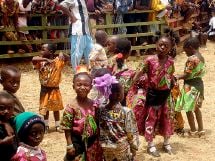
| |
| International Women's Day provides a chance for Cameroonian women to buy brightly colored fabric. They also get to drink in the bars. | |
| Observed by | Worldwide |
| Type | International |
| Significance |
|
| Date | March 8 |
International Women's Day (IWD), marked annually on March 8, is a major day of global celebration for the economic, political, and social achievements of women. The day commemorates the political protests on March 8, 1857, 1859, and 1908, when women marched through New York City demanding shorter hours, better pay, and voting rights.
The holiday that developed from these beginnings blended the culture of many countries, especially Russia and the countries of the former Soviet bloc. Many celebrations of the day emphasize the political and human rights theme for women, as designated by the United Nations. In others, the flavor of the day is not very political and is mainly an occasion for men to express their love to the women around them, similar to Mother's Day and Valentine's Day.
International Women's Day is often celebrated as the first spring holiday, falling close to the first day of the spring season.
History
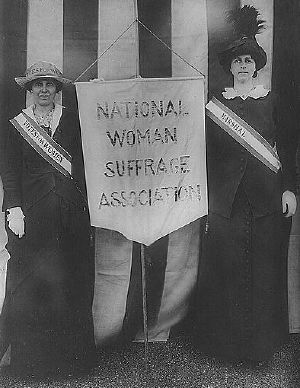
In the later half of the turbulent nineteenth century amid rapid world industrialization, there was great population growth and many new ideas were being born. Women began to seek better treatment at their work sites and other rights. On March 8, 1857, women garment workers in New York City demonstrated against their inhumane working conditions and low wages. They were attacked by the police and dispersed. Two years later, the first female labor union was formed by these women to try to protect themselves, asking for basic rights in the workplace.[1]
On March 8, 1908, 15,000 women marched through New York City demanding shorter work hours, better pay, voting rights, and an end to child labor. Their slogan was "Bread and Roses," bread symbolizing economic security, and roses meaning a better quality of life. In May, the Socialist Party of America designated the last Sunday in February for the observance of National Women's Day. Following the Socialist Party's declaration, the first ever National Woman's Day was celebrated in the United States on February 28, 1909. Women continued to celebrate it on the last Sunday of that month through 1913.
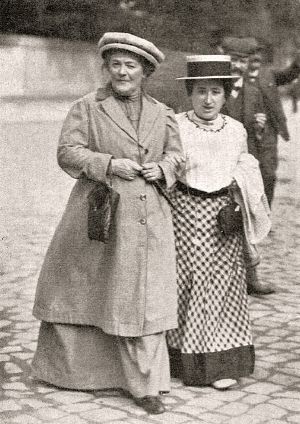
An international Women's Day was soon proposed at a conference in Copenhagen in 1910, held by socialist organizations from around the world. Clara Zetkin, a German socialist, suggested the idea to commemorate the strike of garment workers in the United States. The proposal received unanimous approval by over 100 women from 17 countries, including the first three women elected to the parliament of Finland. Beyond the garment workers strike, the Day was established to honor the movement for women's rights in general, including the right to vote (suffrage). At that time, no fixed date was selected for the observance.
This declaration caused an International Women's Day to be commemorated in 1911 for the first time in Austria, Denmark, Germany, and Switzerland. March 19 saw over a million men and women in a series of rallies worldwide. In addition to calling for the right for women to vote and to hold public office, they demanded the right to work and an end to discrimination on the job.
On March 25, 1911, a tragic accident in New York City took the lives of over 140 workers, mostly young Italian and Jewish immigrant girls working at the Triangle Shirtwaist Company, due to a lack of safety measures. The Women's Trade Union League and the International Ladies' Garment Workers Union led many of the protests against this avoidable disaster. A silent funeral march brought out over 100,000 people. Subsequent International Women's Day commemorations often reminded participants of this horrific event.
Russian women observed their first International Women's Day on the last Sunday in February 1913 to strike for "bread and peace" during the era of World War I. Political leaders opposed the timing of the strike, but the women went on anyway. The demonstrations proved to be an early stage of the Russian Revolution of 1917. Four days after the demonstration, the Czar of Russia abdicated and the provisional government granted Russian women the right to vote. Women held rallies in Europe on or around March 8, either to protest the war or to express solidarity with their sisters.
The poster (right) depicts the original spirit of IWD in the former Soviet Union, "The 8th of March is the day of the rebellion of the working women against kitchen slavery" and "Down with the oppression and narrow-mindedness of household work!"
Following the October Revolution, the Bolshevik feminist Alexandra Kollontai persuaded Lenin to make International Women's Day an official holiday in Russia. It was duly established, but was a working day until 1965. On May 8, 1965, by the decree of the USSR Presidium of the Supreme Soviet International Women's Day was declared as a non-working holiday in the USSR "in commemoration of outstanding merits of the Soviet women in communistic construction, in the defense of their Motherland during the Great Patriotic War, their heroism and selflessness at the front and in rear, and also marking the big contribution of women to strengthening friendship between peoples and the struggle for peace."
Associated as it was with leftist causes, the IWD waned in popularity outside of the Soviet bloc until well after WWII, but was revived by the rise of feminism in the 1960s. Since that time, International Women's Day has increased in importance as a platform for supporting women's rights in developed and developing countries alike.
In December 1977, the UN General Assembly adopted a resolution proclaiming a United Nations Day for Women's Rights and International Peace. The United Nations has held four global conferences which support the demand for women's rights and participation in the political and economic process and make it a growing reality.
In 1975, the UN drew global attention to women's concerns by calling for an International Women's Year and convening the first conference on women in Mexico City. The next was held in Copenhagen in 1980. The third was held in 1985, in Nairobi. In 1995, Beijing hosted the Fourth World Conference on Women for representatives from 189 countries, who agreed that inequalities between women and men have serious consequences for the well-being of all people.
The conference declared a set of goals for progress of women in various areas including politics, health, and education. The final document issued by the conference (called the "Platform for Action") states: "The advancement of women and the achievement of equality between women and men are a matter of human rights and a condition for social justice and should not be seen in isolation as a women's issue."
Five years later, in a twenty-third special session of the United Nations General Assembly a report, "Women 2000: Gender Equality, Development and Peace for the 21st Century" reviewed the progress the world has made towards achieving the goals set out by the Beijing conference. Known as the "Beijing +5" conference, delegates found both progress and persevering obstacles. The delegates made "further agreements to continue carrying out the initiatives of the 1995 women's conference."[2]
Results
As a result of the international focus on Women in 1975, a number of institutions were established:
- International Research and Training Institute for the Advancement of Women (INSTRAW)
- United Nations Development Fund for Women (UNIFEM)
- International Women's Tribune Center, 1976[3]
- Women's Studies Resource Centre was established in South Australia during July[4]
- Women's Electoral Lobby in Australia[5]
Also, the United Nations made women's issues a high priority item on their Millennium Development Goals (MDG).
Women's Day in modern culture
The day is an official holiday in Albania, Algeria, Armenia, Azerbaijan, Belarus, Bosnia and Herzegovina, Brazil, Burkina Faso, Cameroon, China, Cuba, Italy, Laos, Kazakhstan, Kyrgyzstan, Macedonia, Moldova, Mongolia, Montenegro, Poland, Romania, Russia, Serbia, Tajikistan, Ukraine, Uzbekistan, Vietnam, and Zambia, and is observed by men giving the women in their lives—mothers, wives, girlfriends, colleagues, and so on—flowers and small gifts. In some countries (such as Romania) it is also observed as an equivalent of Mother's Day, where children also give small presents to their mothers and grandmothers.
After the collapse of the Soviet Union, celebrations of IWD were abandoned in Armenia. Instead April 7 was introduced as a state holiday of "Beauty and Motherhood." The new holiday immediately became popular among Armenians, as it commemorates one of the main holidays of the Armenian Church, Annunciation. However, people still celebrate IWD on March 8 as well.
In Italy, men give yellow mimosas to women to celebrate the day. Yellow mimosas and chocolate are also one of the most common March 8 presents in Russia. In Bosnia and Herzegovina, Brazil, Croatia, Hungary, Romania, Moldova, Macedonia, Montenegro, Poland, Bulgaria, Slovenia, and Serbia the custom of giving women flowers also prevails. Women sometimes get gifts from their employers too. School children often bring gifts for their teachers as well.
In countries like Portugal and Romania, on the night of March 8, groups of women celebrate in "women-only" dinners and parties.
In India, IWD holds great significance during the daytime celebrations which highlights the power of women in the modern era and how vital their role is in society.
The 2005 Congress (conference) of the British Trades Union Congress overwhelmingly approved a resolution calling for IWD to be designated a public holiday in the United Kingdom.
International Women's Day encountered violence in Tehran, Iran on March 4, 2007, when police beat hundreds of men and women who were planning a peaceful demonstration. Police arrested 26 women and many were released after several days of solitary confinement and interrogation. Several prominent community activists, Shadi Sadr and Mahbubeh Abbasgholizadeh, were finally released on March 19, ending a 15-day hunger strike.[6] However, not all women arrested have been released and there have been disparate international media reports suggesting as many as 70 arrests.[7]
Today, many events are held by women's groups around the world. Many governments and organizations around the world support IWD. The United States designates the whole month of March as "Women's History Month." Global interest in IWD shows a steady increase.
In 2007, the U.S. State Department initiated an Annual International Woman of Courage Award, presented by Secretary of State Condoleezza Rice and Undersecretary of State Paula Dobriansky, to recognize women who have significantly contributed to peace making around the world.
U.S. embassies recommend notable women and eight are chosen to be honored at the State Department in the U.S. on March 8.
In addition, there are dozens of programs held in March to commemorate the day in the United States. Numerous groups, from The Initiative for Inclusive Security to Women's Federation for World Peace, the United States' Women's Middle East Peace Initiative (WMEPI) hold events which educate about and highlight the situation of women struggling for equality and peace in the world.
University support
A number of universities around the world have done notable research into women's issues and advancement and use International Women's Day as a platform for useful events and opportunities to educate society about the issues surrounding women's equality. Key active universities to date who have supported International Women's Day are:
- Bethlehem University, Palestine; Boise State University, Idaho; George Washington University, Washington, DC; La Trobe University, Bundoora, Australia; London City & Islington College, Fordham University, New York City; Monash University, Australia; University of Colorado, University of Kansas, University of Minnesota, University of Vermont, and University of Western Sydney, Australia.[8]
Corporate support
There has been a move by a number of global corporations to support IWD more actively. Some have created their own programs, while others support national or international programs. For the March 8 commemoration, Google changes its logo on its global search pages. HSBC corporation has hosted the largest and longest running IWD event in the United Kingdom through its global women's company, Aurora which hosts a free worldwide register of IWD local events so that women and the media can locate local activity. In 2007, Nortel sponsored IWD activities for thousands of women in over 20 countries. Nortel connects its global workforce though a "coordinated program of high-level IWD activity."
Accenture corporation also supports this effort both online through an IWD webcast and in the public sphere. Accenture sends more than 2,000 of its employees to participate in leadership development sessions, career workshops and corporate citizenship events held across six continents—in eight cities in the United States and in Argentina, Australia, Brazil, Canada, Germany, India, Ireland, Italy, Japan, Spain, South Africa, and the UK for International Women's Day.
Media support
Annually, media coverage of International Women's Day is significant, ranging from small editorials in provincial and regional newspapers to large-scale and in-depth global specials and features. Some media bodies cover this event more extensively than others:
- Aljazeera TV, Doha, Qatar
- BBC, UK
- Bloomberg, UK
- Colorado Daily Newspaper, U.S.
- CNN, U.S.
- Guardian Newspapers Ltd, UK
- KUJH-TV, Kansas, U.S.
- Radio Prague, Czech Republic
- Russia Today, Russia
- Women's Radio Fund, Vancouver, Canada
Notes
- ↑ Temma Kaplan, On the Socialist Origins of International Women's Day, in Feminist Studies, 11, 1985, S. 163-171.
- ↑ "Women 2000: Gender Equality, Development and Peace for the Twenty-first Century" United Nations General Assembly Special Session, New York, 5-9 June 2000. Retrieved March 9, 2022.
- ↑ Connecting Women Globally for Social Change International Women's Tribune Centre (IWTC). Retrieved March 9, 2022.
- ↑ Women's Movement page 6. State Library South Australia. Retrieved March 9, 2022.
- ↑ Women's Electoral Lobby. Retrieved March 9, 2022.
- ↑ Iran: Release Women's Rights Advocates Human Rights Watch, March 7, 2007. Retrieved March 9, 2022.
- ↑ Frances Harrison, Iranian women struggle for equality BBC, March 8, 2007. Retrieved March 9, 2022.
- ↑ History of International Women's Day International Women's Day. Retrieved March 9, 2022.
ReferencesISBN links support NWE through referral fees
- Bolden, Tanya. 33 Things Every Girl Should Know About Women's History: From Suffragettes to Skirt Lengths to the E.R.A. Crown Books for Young Readers, 2002. ISBN 978-0375811227
- Franklin, Robin, and Tasha Lebow Wolf Franklin. Remember the Ladies: A Handbook of Women in American History. Illinois State Board of Education, 1984.
- Howard, Angela, and Francis M. Kavenik (eds.). Handbook of American Women's History. Sage Publications, 2000. ISBN 0761916350
- Jones, Constance. 1001 Things Everyone Should Know About Women's History. Main Street Books, 2000. ISBN 978-0385483872.
- Kandel, Liliane, and Françoise Picq, "Le Mythe des origines à propos de la journée internationale des femmes." In La Revue d'en face 12, 1982.
- Kaplan, Temma. "On the Socialist Origins of International Women's Day." In Feminist Studies 11, 1985.
- Lunardini, Christine A. What Every American Should Know About Women's History: 200 Events That Shaped Our Destiny. Bob Adams Inc. Publishers, 1994. ISBN 978-1558504172.
External links
All links retrieved March 9, 2022.
- International Women's Day United Nations
- National Women’s History Alliance
- International Women's Day
Credits
New World Encyclopedia writers and editors rewrote and completed the Wikipedia article in accordance with New World Encyclopedia standards. This article abides by terms of the Creative Commons CC-by-sa 3.0 License (CC-by-sa), which may be used and disseminated with proper attribution. Credit is due under the terms of this license that can reference both the New World Encyclopedia contributors and the selfless volunteer contributors of the Wikimedia Foundation. To cite this article click here for a list of acceptable citing formats.The history of earlier contributions by wikipedians is accessible to researchers here:
The history of this article since it was imported to New World Encyclopedia:
Note: Some restrictions may apply to use of individual images which are separately licensed.
